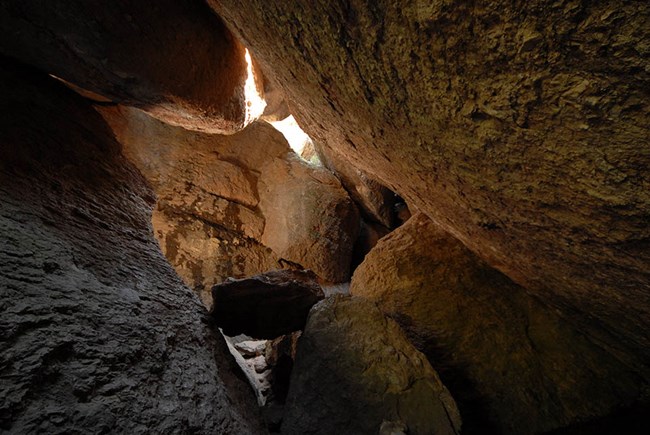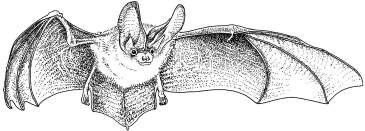Last updated: May 10, 2018
Article
Bats and Bear Gulch Cave

NPS / Shawn Thomas
Why is Bear Gulch Cave sometimes closed?
Bear Gulch Cave is currently home to a colony of several hundred Townsend's big-eared bats. It is the largest colony known between San Francisco and the Mexican border. Because the bats roost on walls and ceilings of large rooms, rather than tucked away in cracks and crevices, they are especially sensitive to human disturbance.
Following the colony's discovery in 1997, the cave was closed for several years to study the bats. We used information from these studies to develop a plan to allow both people and bats to use the cave. We found that although the bats only use the upper portion of the cave during most of the year, they use the entire cave at the beginning of the maternity season, and they leave the cave entirely for short periods in the spring and fall. During breeding periods, the reproductive female bats form a temporary association with each other for the purposes of giving birth, nursing, and weaning their pups. This "maternity colony" uses the cave from approximately May through September. Both males and females also use the cave for overwintering, typically from November through March.
Townsend's big-eared bats also use the Balconies Cave to a lesser extent, where they often occupy areas out of sight of the trail.
What is the schedule for the seasonal opening of Bear Gulch Cave?
The schedule below is based on how the Townsend's big-eared bats have used Bear Gulch Cave since 1997. Because the bats are wild animals whose life cycle depends on many unpredictable factors (e.g weather), they sometimes surprise us by changing their schedule. If you are planning a visit to Bear Gulch Cave, please call ahead or check the park website to avoid surprises.
| March | The lower half of the cave will be open for the full month. The entire cave will probably be open for at least the last week of the month, possibly the entire month. |
|---|---|
| April 1 - mid May | The Iower half of the cave will be open. |
| Mid May - mid July | The entire cave will be closed to protect the colony of bats as they raise their young. |
| Mid July - September 30 | The lower half of the cave will be open. |
| October | The Iower half of the cave will be open for the full month. The entire cave will probably be open for at least the last week of the month, possibly the entire month. |
| Nov. 1 to end of February | The lower half of the cave will be open. |

NPS / Jessica Weinberg McClosky
If Bear Gulch Cave is closed, what else is there to do?
Except during periods of high stream flow, Balconies Cave provides a great opportunity to experience a talus cave. It is accessible from the East Side of the park via the Old Pinnacles Trail, or from the West Side of the park via the Balconies Trail.
However, the Bear Gulch Cave area can be a great place to hike even when the cave is closed. The Moses Spring Trail winds along the canyon above the cave, providing excellent views of the geologic processes that created the cave, and of the boulders forming the roof of the cave.
Near the stream crossing below Bear Gulch Dam is the junction with the cave trail, which leads about 100 feet into the upper end of the cave. This portion of the trail is open all year. Along the Moses Spring Trail is the luxuriant fern grotto at the base of the often dry waterfall. Moses Spring flows year-round and just up the trail. At the end of the trail is Bear Gulch Reservoir, home to abundant frogs, garter snakes, dragonflies, and other wildlife.

Are bats really blind? (and other bat myths)
"Blind as a bat."
Bats not only "see" the world with echolocation, but they have good eyesight. Some bats find their food exclusively with sight and they can see better than humans in dim light.
"They get tangled in your hair."
Bats can be very curious. They will oflen circle around something or someone new in their air space to take a second look. They certainly aren't trying to get tangled in your hair, but it does happen on rare occasion.
"Bats are flying mice."
Bats are actually more closely related to primates than to rodents. Most bats give birth to only one "pup" per year which they feed milk. Other than humans, bats are the longest lived mammals in North America; one little brown bat (Myotis lucifugus) is at least 34 years old.
"Bats are just pests. "
Bats are economically and ecologically important animals, providing ecosystem services such as pollination, seed dispersal, and insect predation. Although they live on all continents except Antarctica, they are on the decline worldwide.
"All bats carry rabies."
Bats are not "carriers" of rabies; less than 1% of bats contract rabies and die. Like many animals, they will bite in self defense. If you see a bat on the ground, it is probably sick. Avoid handling bats and other wildlife.
How many species of bats live in Pinnacles National Park?
Townsend’s big-eared bats share the caves at Pinnacles with several other bat species, but these usually tuck themselves out of sight. Cracks and crevices in the numerous cliffs and rock outcrops at Pinnacles are also home to many bats. A couple species roost in trees. Their fur resembles tree bark.
All of the fourteen bat species at Pinnacles and forty-one of the forty-four North American bats are insectivorous, meaning they eat insects and spiders. Three North American species eat fruit or nectar. There are only three species of vampire bats—they live in South America and feed on birds and mammals.
Out of the 23 species of bats in California, 14 are known to occur within Pinnacles National Park:
Western Pipistrelle (Parestrellus hesperus)
Western Red Bat (Lasiurus blossevilii)
Hoary Bat (Lasiurus cinereus)
Townsend's Big-eared Bat (Corynorhinus townsendii)
Pallid Bat (Antrozous pallidus)
Big Brown Bat (Eptesicus fuscus)
California Myotis (Myotis californicus)
Small-footed Myotis (Myotis ciliolabrum)
Long-eared Myotis (Myotis evotis)
Fringed Myotis (Myotis thysanodes)
Long-legged Myotis (Myotis volans)
Yuma Myotis (Myotis yumanensis)
Mexican Free-tailed Bat (Tadarida brasiliensis)
Western Mastiff Bat (Eumops perotis)
Additional Resources
Links
San Francisco Bay Area Inventory & Monitoring Network
Pacific Coast Science & Learning Center
San Francisco Bay Area Network Species Lists - Certified Species lists including residency, abundance, and native/non-native status.
Bat Inventory of Pinnacles National Park
Created December 2011 for Pinnacles National Park.
